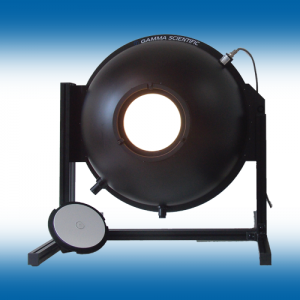Gamma Scientific has a catalog of available standard spheres designed for general use or specific applications, as a light source or detector, and more. Each configuration relies on some general theory for using an integrating sphere:
- Depending on the application, a standard integrating sphere will have at least 2 ports – 1 input port & 1 output port
- All ports on a sphere are typically orthogonal to the sample port position
- The sphere is mounted such that the sample input port is perpendicular to the ground
- Inside the sphere, there is typically a baffle between the sample input port and all other ports to avoid directly viewing the light from the sample
- The sample input port will allow the user to apply a reference light source in order to calibrate the system*
- Everything inside must be coated uniformly, and any open port that is not being used should have a coated port cover in place to avoid light traps
*assuming the use of absolute photometry
Lasers and collimated light sources are typically high intensity, have a narrow bandwidth, and have a small beam profile.
This type of sphere design is suitable for lab bench integration with the built-in post mount and true orthogonal port orientations.
Inside the sphere, we use baffles to shield light from one port being directly viewable from another port. This forces the light to bounce around the sphere before it can be viewed by the detector system.
The higher the number of reflections, the more the light source is mixed together.
A sphere for use in general lighting or luminaire metrology will have 2 standard positions you can place the sample – in the center (4π) or at the side port of the sphere (2π).
Each position has an advantage. The center position is best for samples which have light traveling in all directions, and the side port position is best for samples which have light traveling in a defined direction.


